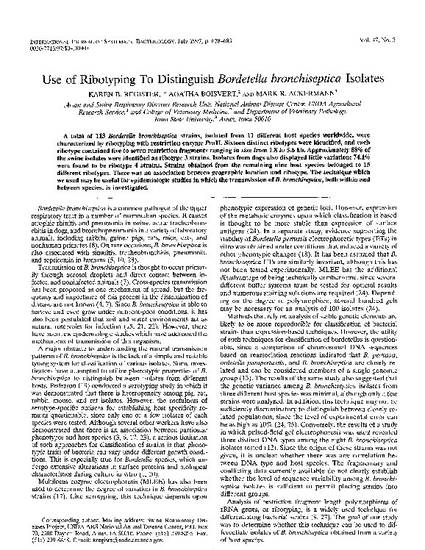
Article
Use of ribotyping to distinguish Bordetella bronchiseptica isolates
International Journal of Systematic and Evolutionary Microbiology
Document Type
Article
Disciplines
Publication Date
7-1-1997
DOI
10.1099/00207713-47-3-678
Abstract
A total of 113 Bordetella bronchiseptica strains, isolated from 11 different host species worldwide, were characterized by ribotyping with restriction enzyme PvuII. Sixteen distinct ribotypes were identified, and each ribotype contained five to seven restriction fragments ranging in size from 1.8 to 5.6 kb. Approximately 88% of the swine isoaltes were identified as ribotype 3 strains. Isolates from dogs also displayed little variation; 74.1% were found to be ribotype 4 strains. Strains obtained from the remaining nine host species belonged to 15 different ribotypes. There was no association between geographic location and ribotype. The technique which we used may be useful for epidemiologic studies in which the transmission of B. bronchiseptica, both within and between species, is investigated.
Rights
Works produced by employees of the U.S. Government as part of their official duties are not copyrighted within the U.S. The content of this document is not copyrighted.
Language
en
File Format
application/pdf
Citation Information
Karen B. Register, Agatha Boisvert and Mark R. Ackermann. "Use of ribotyping to distinguish Bordetella bronchiseptica isolates" International Journal of Systematic and Evolutionary Microbiology Vol. 47 Iss. 3 (1997) p. 678 - 683 Available at: http://works.bepress.com/mark_ackermann/50/

This article is from International Journal of Systematic and Evolutionary Microbiology 47, no. 3 (July 1997): 678–683, doi:10.1099/00207713-47-3-678.